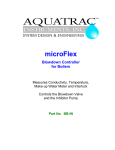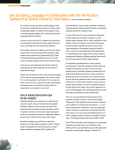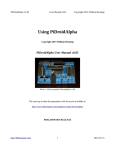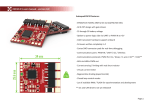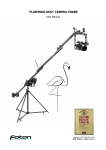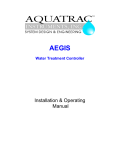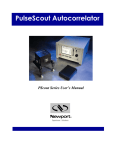Download RAGEBriDGE vI.D Revision 20 Feb 2013
Transcript
RageBridge v1.0 Overview Revision 20 Feb 2013 Mounting Dimensions RageBridge is a motor controller that can drive 2 channels of DC motors from 2 R/C “servo” style PWM inputs, in forward and reverse with no delay. RageBridge features optional channel mixing, 3rd channel direction reversal (“invert”) input, stick travel calibration, signal-loss failsafe, synchronous rectification with regenerative braking, constant-current output mode, and an isolated heat sink plate. Installation RageBridge’s isolated heat spreader plate has four clearance holes for #4 screws (0.130 diameter). The heat spreader plate may be bolted directly to a metal chassis for better thermal performance. Specifications Voltage Input Range Continuous Current Maximum Current Dimensions Weight Inputs 12 – 36v nominal 8 – 50v absolute limits 30A per channel @ 50% duty cycle, 25°C ambient Up to 90A per channel Constant-current mode limited 4.5” x 2” x 0.8” Board only 4.5” x 2.55” x 1.0” With heat sink 3.5oz without wires Logic Power 2x R/C servo for drive signals 500us to 2500us limits 1100us to 1900us default 1x R/C servo for invert control 1x Mixing switch header 5V @ 150mA maximum Heat Management Isolated heat spreader plate RageBridge may also be mounted without the heat sink to minimize dimensions. The board itself has 4x #4-40 screws which may be untightened with a 3/32” hex wrench. Use the following guidelines for best results: 1. Use nonconductive standoffs or spacers to offset the board from the mounting surface. 2. Insulate the underside using electrical tape or brush-on insulation compound to prevent stray metal or wires from shorting. 3. Do not enclose the board in tape, shrink tube, or sealed cases. Doing so will negatively affect the thermal performance and reduce continuous current rating. 1 RageBridge v1.0 Revision 20 Feb 2013 Signal Connection Power Connection The IN1, IN2, and IN3 pin headers accept standard 3-pin servo connectors. The ground wire must be oriented towards the outside of the board. It is generally black or brown. Warning: Do not use RageBridge with only a power supply. The regenerative nature of RageBridge will cause the motor’s kinetic energy to be directed into the power supply upon stopping and can cause high voltage spikes and damage to both supply and controller. A battery must be placed between the supply and controller to absorb this energy if a supply must be used. Connect IN1 to channel 1 of your radio and IN2 to channel 2. If invert control is needed, connect IN3 to a switch channel on your radio. Else, leave it unconnected. Power connections to RageBridge are made using solder terminal holes on the circuit board. The Mixing switch is enabled if the two MIX pins are connected via a jumper (not included). If it is disconnected, the channels are independent. Use 12 to 16 gauge wire. 14 gauge is recommended. The heat sink should be dismounted first for easiest access to the solder terminals. Use a 3/32” hex wrench to undo the four #4-40 screws mounting the board to the heat sink. Both sets of B+ and B- terminals must be connected to power. The board derives logic power from the right side as viewed from above. The voltages may be different between sides provided neither exceeds the board’s capabilities. Example 2 channel connection with mixing header (not included) installed Range and Direction By default, signal pulse widths greater than 1500us is associated with motor terminals 1 (MA1 and MB1) being more positive in voltage. Twist and tin the wire prior to soldering them in the terminals. This prevents frayed wires from shorting neighboring components. Flush cut the resulting solder joint to minimize risk of causing shorts. Invert status is active if the pulse width on IN3 is greater than 1500us. 2 RageBridge v1.0 Revision 20 Feb 2013 Stick Calibration RageBridge’s default pulse width range of 1100us – 1900us can be calibrated to better match your radio travels. Before beginning, we recommend that your radio be set up such that stick-up or stickright is an increasing pulse width. This direction is associated with forward. Disconnect all loads from the controller first, to prevent accidental movement. Example wire installation To calibrate the controller, use the following procedure: Flush cutting the resulting joint to minimize shorting risk 1. Normal and Failsafe Behavior 2. 3. 4. 5. Under normal circumstances when the controller is receiving good signals, the green LED (status) will strobe every 1 second. The motor drivers are active and the default neutral behavior is braking. 6. If either IN1 or IN2 receive an invalid signal, the controller will enter failsafe mode within 1 second. The green LED will strobe rapidly, and the motors will coast freely. 7. 8. 9. If valid signal is received again, the controller will enter normal operation within 0.5 seconds Connect both IN1 and IN2 on the controller to your receiver. Both channels must be calibrated at once. Power on your transmitter. Power on the controller. Apply full forward stick travels within 2 seconds. Hold full forward stick travels for 5 seconds. The green LED will light solid, indicating calibration mode is active. Apply full reverse stick travels and hold for least 2 seconds Release the stick to neutral. Calibration will automatically exit after 2 seconds of neutral signal. The green LED will blink rapidly for 1 second to indicate successful calibration. At any point, if the procedure is not followed or there is a signal error, the calibration mode will simply exit and the controller will enter either Normal or Failsafe mode. 3 RageBridge v1.0 Output Current Adjustment Revision 20 Feb 2013 Warnings A unique feature of RageBridge is its ability to output exactly as much current as you limit it to. This is a departure from generic “smart” current limiting in which you have no control over when the controller will cut its output current! 1. Controller will be hot during and after operation. Do not place controller in contact with low temperature melting materials. Do not handle controller immediately after use. 2. Do not reverse battery polarity. This controller does NOT have reverse polarity protection. Reverse polarity damage is NOT covered under warranty. See the Shipping and Warranty section on e0designs.com for more information. 3. Do not cover the controller or wrap it in insulating materials. Doing so will compromise the controller’s ability to dissipate heat and will reduce the continuous current rating. 4. Do not short the controller or allow conductive materials to contact the board directly. The current limit is not guaranteed to protect against “dead” shorts and board level shorts. 5. Do not use RageBridge with only a power supply. The regenerative nature of RageBridge will cause the motor’s kinetic energy to be directed into the power supply upon stopping and can cause high voltage spikes and damage to both supply and controller. A battery must be placed between the supply and controller to absorb this energy if a supply must be used. RageBridge will output up to your maximum current limit and reduce its output voltage just enough to maintain that current limit if the demand is higher. This offers protection against stalled motors, over-torquing actuators, acceleration-sensitive applications, etc. To adjust the current limit, turn the Max Current trim potentiometer to your desired setting using a nonconductive screwdriver: The default setting is approximately 50 amps. Use a DC ammeter connected to the motor output wire side to verify exact current. The accuracy of the current limit is strongly dependent on motor inductance; for typical iron core motors, the accuracy is ± 2-5 amps. 4





